What are some of the things that happened in April? Read on to find out!
Contents
How to Process an Earth-Venus-Earth Radar Return Signal
Del Mar Electronics and Manufacturing Show Exhibit Report
Take This Job!
Connecting the Dots: Protecting and Improving Amateur Radio Access to 219-220 MHz
Are Multi-Carrier Data Modes Illegal in Amateur Radio?
Lab Equipment Successfully Moved
The Who What When Where Why
Open Research Institute is a non-profit dedicated to open source digital radio work. We do both technical and regulatory work. Our designs are intended for both space and terrestrial deployment. We’re all volunteer.
You can get involved by visiting https://openresearch.institute/getting-started
Membership is free. All work is published to the general public at no cost. Our work can be reviewed and designs downloaded at https://github.com/OpenResearchInstitute
We equally value ethical behavior and over-the-air demonstrations of innovative and relevant open source solutions. We offer remotely accessible lab benches for microwave band radio hardware and software development. We host meetups and events at least once a week. Members come from around the world.
How to Process an Earth-Venus-Earth Radar Return Signal
With receiver data successfully collected by Dwingeloo and Stockert amateur radio astronomy sites during the Earth-Venus-Earth communications event on 22 March 2025, attention moved to processing the data to see if the transmitted carrier wave signal could be detected.
Four transmissions of a carrier wave from the Dwingeloo radio astronomy site were made. Each transmission was 278 seconds long. This time span was selected because it equaled the expected round-trip time from Earth to Venus and back. This would allow the transmitter to transmit for the round trip time, shut down, and then immediately begin receiving what should be the leading edge of the reflected radio signal. Both Dwingeloo and Stockert made time-coordinated in-phase and quadrature (IQ) recordings of the receive spectrum.
IQ samples are complex numbers that are created by sampling a received waveform. IQ samples fully specify any waveform, as long as they are taken at a rate faster than twice the bandwidth of the recorded signal. These IQ time series recordings are then mathematically evaluated in order to reveal the reflected carrier wave spike in the frequency domain.
Raw data (at 1 MSps), decimated data (at 5 kSps), and an example data processing Python Notebook are available from https://data.camras.nl/venus/
The data files are in SigMF format. This format is widely used for IQ signal data recordings. A data file, containing IQ samples, is paired with a metadata file, which has a variety of metadata describing the conditions and configurations of recorded data. Learn more about SigMF at https://sigmf.org
In addition to the SigMF files and a Python Notebook that performs the data analysis, there are also two comma separated value (CSV) files containing the expected frequency offsets and Doppler rates for RX timestamps. There is one for Stockert and one for Dwingeloo. These values are needed by the script in order to correct the received samples frequency shifts due to Doppler.
Once the notebook eve-cw-detect-example.ipynb is downloaded from the site, then all of the 5 kSps files, dwingeloo_venus_doppler.csv and stockert_venus_doppler.csv should also be downloaded.
While the 1 MSps files are higher resolution, the 5 kSps files are more than enough resolution to carry out the math. It takes much less time to process these smaller lower resolution files than the larger higher resolution files, and the results will be exactly the same.
Note: There is a bug in the python package sigmf version 1.2.8 that prevents these files from loading. Please install 1.2.6 or a version greater than 1.2.8. Or, modify the script to set up a SigMFFile instace manually, to evade the bug.
Run the script, and if all goes well, the visualization will show a spike for the carrier wave. Success!
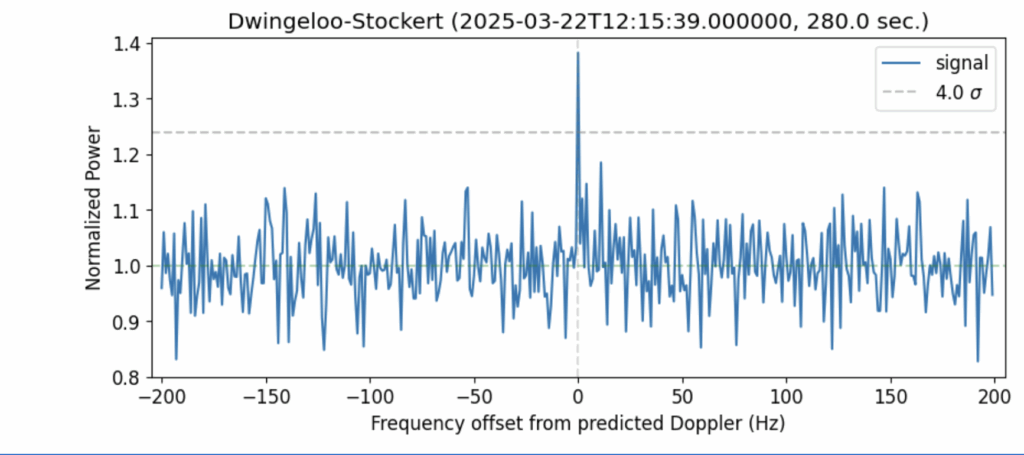
What is this script doing?
Here is a summary of the most important calculations.
The notebook loads the recorded IQ data SigMF files and the Doppler information from CSV files. It then compensates for both the Doppler shift and Doppler rate of change using phase rotation.
# Compensate for Doppler and Doppler rate
dr = np.repeat(doppler_rate, len(data) / len(doppler_rate))
t_s = np.arange(len(data)) / fs
fdrift = -dr # Doppler rate
f0_Hz = -expected_freq_offset # Doppler
phi_Hz = (fdrift * t_s**2) / 2 + (f0_Hz * t_s) # Instantaneous phase.
phi_rad = 2 * np.pi * phi_Hz # Convert to radians.
data = data * np.exp(1j * phi_rad)
This means our signal will be centered at 0 Hz offset for the rest of the processing.
Next, we do some coherent processing. Coherent processing means that we preserve the phase information of the signal. Non-coherent processing just looks at the amplitude. Fast Fourier Transforms (FFT) preserve magnitude and phase.
spectrum = np.fft.fftshift(np.fft.fft(data.reshape(-1, int(sample_rate))))
The data is reshaped to have segments of length sample_rate (which is 5000 samples per second), meaning each FFT operation is performed on exactly 1 second of data. This is the coherent integration time used in the experiment.
This is less than the maximum coherency time available due to Doppler rate of change limitations (~1.3 seconds), but it is larger than another maximum limit due to Doppler Spread from Venus’ rotation (we calculated a much lower 0.03 seconds based on 31 Hz). The reasoning for being able to use 1 second coherent integration time (based on a Doppler Spread of 1Hz) is that the updated Doppler Spread is not as bad as we originally calculated
After obtaining the FFT results, the notebook performs non-coherent integration by averaging the magnitudes of the FFT outputs. This means it discards the phase information and combines power/energy over the entire recording run.
spec_sum = np.mean(np.abs(spectrum), axis=0)
The axis=0 parameter means it’s averaging across multiple 1-second segments, effectively performing non-coherent integration over the entire 278 second long recording duration. This allows us to integrate over much longer periods than would be possible with purely coherent integration.
Dwingeloo’s Thomas Telkamp invites the community to expand on and improve the Python notebook, saying in late March 2025, “A few remarks: 1) use the 5ksps files, 2) there is an example notebook now on how to process the data, and 3) you’re not supposed to duplicate it, but to improve it!”
Also, please read the excellent analysis from Dr. Daniel Estevez at https://destevez.net/2025/04/analysis-of-the-camras-venus-radar-experiment/
And, additional details from Cees Bassa can be found at https://www.camras.nl/en/blog/2025/first-venus-bounce-with-the-dwingeloo-telescope/
Open Source Digital Radio Exhibit at the Del Mar Electronics and Manufacturing Show
Several enthusiastic volunteers represented Open Research Institute at the Del Mar Electronics and Manufacturing Show, held at the San Diego County Fairgrounds 23-24 April 2025. Below is an embedded image of the booth right before the show opens and five videos of ORI’s exhibits at various times throughout the show.
https://www.mfgshow.com/index.html
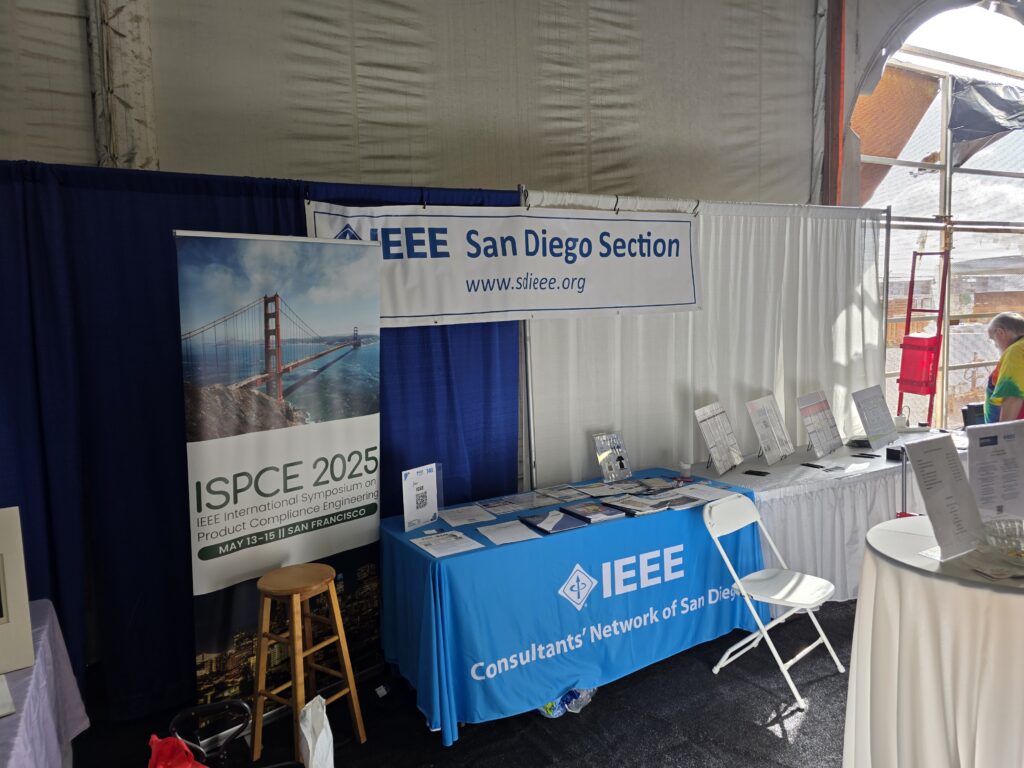
Take This Job
1 April 2025
Interested in Open Source software and hardware? Not sure how to get started? Here’s some places to begin at Open Research Institute. If you would like to take on one of these tasks, please write hello@openresearch.institute and let us know which one. We will onboard you onto the team and get you started.
Opulent Voice:
Add a carrier sync lock detector in VHDL. After the receiver has successfully synchronized to the carrier, a signal needs to be presented to the application layer that indicates success. Work output is tested VHDL code.
Bit Error Rate (BER) waterfall curves for Additive White Gaussian Noise (AWGN) channel.
Bit Error Rate (BER) waterfall curves for Doppler shift.
Bit Error Rate (BER) waterfall curves for other channels and impairments.
Review Proportional-Integral Gain design document and provide feedback for improvement.
Generate and write a pull request to include a Numerically Controlled Oscillator (NCO) design document for the repository located at https://github.com/OpenResearchInstitute/nco.
Generate and write a pull request to include a Pseudo Random Binary Sequence (PRBS) design document for the repository located at https://github.com/OpenResearchInstitute/prbs.
Generate and write a pull request to include a Minimum Shift Keying (MSK) Demodulator design document for the repository located at https://github.com/OpenResearchInstitute/msk_demodulator
Generate and write a pull request to include a Minimum Shift Keying (MSK) Modulator design document for the repository located at https://github.com/OpenResearchInstitute/msk_modulator
Evaluate loop stability with unscrambled data sequences of zeros or ones.
Determine and implement Eb/N0/SNR/EVM measurement. Work product is tested VHDL code.
Review implementation of Tx I/Q outputs to support mirror image cancellation at RF.
Haifuraiya:
HTML5 radio interface requirements, specifications, and prototype. This is the primary user interface for the satellite downlink, which is DVB-S2/X and contains all of the uplink Opulent Voice channel data. Using HTML5 allows any device with a browser and enough processor to provide a useful user interface. What should that interface look like? What functions should be prioritized and provided? A paper and/or slide presentation would be the work product of this project.
Default digital downlink requirements and specifications. This specifies what is transmitted on the downlink when no user data is present. Think of this as a modern test pattern, to help operators set up their stations quickly and efficiently. The data might rotate through all the modulation and coding, transmitting a short loop of known data. This would allow a receiver to calibrate their receiver performance against the modulation and coding signal to noise ratio (SNR) slope. A paper and/or slide presentation would be the work product of this project.
Connecting the Dots: Protecting and Improving Amateur Radio Access to 219-220 MHz
Introduction
The 219-220 MHz band represents both a challenge and an opportunity for the amateur radio community. Recent events highlighted in the Convair/220 Amateur Radio Club’s newsletter “Contrails” and the DR0NK Radio Network’s report demonstrate how vigilance is essential for protecting our spectrum rights. While our ongoing work at Open Research Institute (ORI) focuses on removing unnecessary regulatory barriers to make this valuable spectrum more accessible, it took boots on the ground to defend the 220 band from unexpected and harmful interference.
The Twin Challenges: Interference and Regulatory Burden
The amateur radio community currently faces two related challenges in the 220 MHz vicinity. First, external threats. As documented by the DR0NK Radio Network (https://k1ct.freeshell.org/c220.html), experimental licenses granted without proper consideration of existing amateur services have caused significant interference to operations in the 222-225 MHz band. See article in Contrails, the CONVAIR Amateur Radio Club’s April 2025 newsletter, below.
This experience serves as a warning about potential threats to adjacent frequencies. In addition, regulatory barriers still exist. Our work at ORI has identified that the 219-220 MHz band is hampered by outdated notification requirements that create unnecessary administrative burdens without providing meaningful interference protection.
Our Regulatory Approach
ORI has been actively participating in the FCC regulatory process with proposals that would streamline operations while maintaining necessary technical safeguards. We have spoken up about removing the outdated and burdensome notification and permissions requirements for amateur radio stations operating on 219 MHz.
See https://www.openresearch.institute/2025/04/01/fcc-filing-for-219-mhz-rules-changes-from-ori/
Our most recent comments go further than this, and support removing regulations requiring interference studies to protect television channels 10 and 13 (this is also supported by AAR and WISPA) along with reiterating the elimination of all of the outdated notification requirements in Part 80 and Part 97.
REPLY COMMENTS OF OPEN RESEARCH INSTITUTE, INC
Open Research Institute, Inc replies in support of certain comments filed by the Association of American Railroads (AAR) [1], WISPA [2], and Steven K. Stroh [3].
Specifically, we support section II of the AAR comments requesting the removal of regulations requiring interference studies to protect television stations using Channel 10 and Channel 13.
We also support WISPA’s comments regarding Part 80 of the Commission’s regulations requesting the same removal of interference studies. These regulations are outdated and based
on a coast station use of AMTS that was never widely deployed. Furthermore, we support Steven K. Stroh’s recommendation to delete 97.307(f)(13) which restricts amateur station emissions
in 219-220 MHz (hereafter “219”) from using more than 100 kHz of bandwidth. We take no position on other comments made by the AAR, WISPA, or Steven K. Stroh.
We believe that our comments [4] serve to encourage wider use of AMTS spectrum by removing other burdensome notification regulations in Part 80
that require AMTS licensees to notify the American Radio Relay League and Interactive Systems of station locations. Our proposed removal of notification requirements for
219 in Part 97 serve the same purpose.
The AAR observes that most Positive Train Control deployments are “[…] primarily located within railroad rights-of-way and generally away from households […]”.
This necessarily limits the potential for harmful interference given we do not advocate for mobile use of 219 by amateur stations.
Beyond documented Amateur Radio Service history in coexisting with primary users, we believe our proposed retention of many of the restrictions on amateur use (secondary status, reduced power levels, fixed stations, and digital emissions) will sufficiently reduce the possibility of harmful interference with AMTS licensees. In sum, we believe that our proposals, combined with those of AAR, WISPA, and Steven K. Stroh will lead to more efficient commercial and amateur use of 219-220 MHz. In keeping with the Commission’s goal of removing regulations, all of these
proposals can be implemented solely as rule deletions.
[1] https://www.fcc.gov/ecfs/search/search-filings/filing/10412030480052
[2] https://www.fcc.gov/ecfs/search/search-filings/filing/104111661931041
[3] https://www.fcc.gov/ecfs/search/search-filings/filing/10412237159703
[4] https://www.fcc.gov/ecfs/search/search-filings/filing/10329271641887
In the past, we have supported the removal of the 100 kHz bandwidth restriction for amateur stations in the 219-220 MHz band, and continue to do so now.
The Connection to Recent Interference Cases
The DR0NK Radio Network’s experience with interference from improperly granted experimental licenses offers valuable lessons for our regulatory advocacy. Documentation is critical. Success came through “coordinating efforts” and “documenting and communicating real issues.”
Technical arguments prevaied. Successful spectrum defense relied on demonstrating actual harmful interference through technical measurements, not administrative formalities.
Community vigilance works. As DR0NK notes, “the price of freedom, and of spectrum, is eternal vigilance.” This vigilance allowed them to detect and address interference that administrative processes failed to prevent.
Conclusion
ORI’s approach balances regulatory streamlining with responsible spectrum sharing. By eliminating outdated administrative barriers while maintaining secondary status and technical safeguards, we can make the 219-220 MHz band more accessible to amateurs while protecting primary users. The recent experiences documented by the DR0NK Radio Network demonstrate that our community can effectively protect spectrum through technical vigilance rather than bureaucratic procedures. Removing unnecessary and outdated bureaucratic procedures clears the way for operators and enthusiasts to effectively and efficiently police the bands.
Are Multi-Carrier Data Modes Illegal in Amateur Radio?
Mike McGinty W2FBI, organizer of the Amateur Cellular project (https://xcl.is) has a concern about Ham LTE.
He writes,
“The more I read part 97, the more I convinced myself that actually, Ham LTE and indeed all ham multi-carrier data is illegal. Further, all identification over almost all digital modes is illegal.
The important part is under Authorized Emissions.
See https://xcl.is/news/standardized_ham_radio_lte_v1_rc/
Does part 97 needs rephrasing?”
The Key Issues with Emission Designators in Part 97
Mike McGinty raises a legitimate question about the interpretation of Part 97 rules regarding emission types and digital codes, particularly for multi-carrier data modes like LTE. The core of the issue appears to be in two parts of 47 CFR Part 97:
1 Definition of Emission Types (§97.3(c)): This section defines authorized emission types for amateur radio, including RTTY and data emissions with specific designators where only “a digital code of a type specifically authorized in this part may be transmitted.” (https://www.ecfr.gov/current/title-47/chapter-I/subchapter-D/part-97)
2 RTTY and Data Emission Codes (§97.309): This section lists both specified digital codes that are authorized, and conditions under which unspecified digital codes may be used depending on frequency band and other requirements. (https://www.law.cornell.edu/cfr/text/47/97.309)
The potential contradiction arises because §97.307(f)(8) authorizes “A RTTY or data emission having designators with A, B, C, D, E, F, G, H, J or R as the first symbol; 1, 2, 7, 9 or X as the second symbol; and D or W as the third symbol” (https://www.law.cornell.edu/cfr/text/47/97.307)
while the definition in §97.3 appears to be more restrictive for some emission types.
The LTE Question
LTE (Long-Term Evolution) uses OFDMA (Orthogonal Frequency-Division Multiple Access), which is a multi-carrier modulation technique. The emission designator for such transmissions could be something like G7W or D7W based on emission designator standards. There is ambiguity about whether this precisely fits within the authorized emission types in Part 97.
Possible Interpretations
There are several ways to interpret these rules:
1 Strict Interpretation: Only specifically listed emission designators are allowed, making some modern digital modes (including amateur LTE implementations) potentially unauthorized.
2 Liberal Interpretation: The rule allowing “unspecified digital codes” (§97.309(b)) encompasses modern digital modes as long as they meet bandwidth and other technical requirements. Modes includes the way they are emitted and we don’t really have a problem.
3 Documentation-Based Interpretation: As discussion about this question widened, Paul Williamson KB5MU suggested that there may be an “established understanding with FCC” that emission modes can be unspecified in the same way that digital codes can be unspecified, as long as the full details of the mode are published.
Is There any Existing FCC Guidance or Documentation?
After Paul suggested that there might be a letter or document that addresses this, I made attempts to search and asked around. While I was unable to find specific FCC guidance documents or formal letters directly addressing this question for amateur radio LTE or similar modern multi-carrier digital modes, I can say that there is precedent for the FCC taking a more permissive approach to new digital modes:
1 In 2016, the FCC proposed rule changes to remove limitations on the symbol rate for amateur radio data transmissions while maintaining bandwidth limitations (https://www.federalregister.gov/documents/2016/08/12/2016-19085/amateur-radio-service-rules-to-permit-greater-flexibility-in-data-communications) I assert that this shows a general trend toward technical flexibility.
2 The provision in §97.309(a)(4) indicates that “An amateur station transmitting a RTTY or data emission using a digital code specified in this paragraph may use any technique whose technical characteristics have been documented publicly” (https://www.law.cornell.edu/cfr/text/47/97.309) which strongly suggests openness to innovation within specified categories and is a rule widely used by experimenters. There are no reports of restrictions, repercussions, or negative outcomes when amateur operators have relied upon public documentation for digital codes not otherwise specified.
This begs the question: Can we assume that “An amateur station transmitting a RTTY or data emission may use any emissions technique whose technical characteristics have been documented publicly”?
Interpretation
The interpretation of amateur radio service rules regarding multi-carrier modes like LTE falls into a gray area that hasn’t been explicitly addressed by the FCC. The concern that Mike raises is therefore valid – there is tension between the specific emission designator definitions and the broader allowances for unspecified digital codes.
Paul’s suggestion that “there is an established understanding with FCC that emission modes can be unspecified in the same way that digital codes can be unspecified, as long as the full details of the mode are published” aligns with the spirit of amateur radio’s experimental nature, but I couldn’t find formal documentation supporting this understanding.
Given the FCC’s trend toward embracing technical innovation while maintaining good spectrum practices, this is indeed potentially a “bear best left unpoked” as Paul suggested, unless the amateur radio community seeks formal clarification through a petition for declaratory ruling from the FCC.
We could take the opportunity to suggest clarifying language that would explicitly encompass modern multi-carrier digital modes while maintaining appropriate technical standards and interference protection.
Option 1: Adding Specific Commercial LTE Emission Designators
Commercial LTE typically uses emission designators like G7W, D7W, or W7D, depending on the specific implementation. Simply adding these to the list of authorized designators would be a straightforward and easy approach, but it has some serious limitations:
1 It would address only the current implementation of LTE without future-proofing for evolving technologies.
2 It might not address other multi-carrier modes beyond LTE.
3 It would require updating the rules again for each new technology.
4 It doesn’t really fit into the Delete, Delete, Delete 25-133 proceeding because it’s adding and not taking away.
Option 2: Comprehensive Modernization Approach
A more forward-looking approach would be to amend 47 CFR Part 97 with language that explicitly embraces modern digital techniques while maintaining appropriate technical standards.
Draft:
I. INTRODUCTION
1. In this Notice of Proposed Rulemaking (or comment, or reply-to), we share proposed amendments to Part 97 of the Commission’s Rules governing the Amateur Radio Service. These proposed rules clarify and update the authorized emission types for digital communications. These proposed changes aim to explicitly accommodate modern multi-carrier digital modes, such as those based on orthogonal frequency-division multiplexing (OFDM) technologies, while maintaining appropriate technical standards and interference protection.
II. BACKGROUND
2. The Commission’s rules in Part 97 define various emission types authorized for amateur radio operators in § 97.3(c) and specify standards for RTTY and data emissions in § 97.309. These rules were established before many modern digital communication techniques were developed and in some cases do not clearly accommodate innovative technologies now commonly used in other radio services, including highly popular and efficient multi-carrier modulation methods.
3. Multi-carrier modulation techniques, such as those used in LTE (Long-Term Evolution) and other OFDM-based systems, offer significant advantages for efficient spectrum use and robustness against interference. Amateur radio operators have adapted these technologies for experimentation and improved communications, but questions have arisen about whether such modes are fully compliant with existing Part 97 emission designator requirements.
III. DISCUSSION
4. We propose to amend Part 97 to clarify that modern multi-carrier digital modes are authorized for amateur radio communications, provided they comply with other technical parameters specified for the relevant frequency bands. For example, a multi-carrier mode that exceeds the entire allocated bandwidth of an amateur band would obviously not be an authorized transmission. Specifically, we propose the following changes:
A. Proposed Rule Changes
5. We propose to amend § 97.3(c)(2) as follows:
(2) Data. Telemetry, telecommand and computer communications emissions having
(i) designators with A, B, C, D, E, F, G, H, J, R or W as the first symbol, 1, 2, 7, 9 or X as the second symbol, and D or W as the third symbol;
(ii) emission J2D; and
(iii) emissions A1C, F1C, F2C, J2C, and J3C having an occupied bandwidth of 500 Hz or less when transmitted on an amateur service frequency below 30 MHz.
6. We further propose to amend § 97.309 by adding a new paragraph (c) as follows:
(c) An amateur station may transmit any digital emission using a multi-carrier modulation technique, including but not limited to orthogonal frequency-division multiplexing (OFDM), provided that:
(1) The emission complies with all bandwidth limitations specified in § 97.307 for the frequency band in use;
(2) The technical characteristics of the emission have been documented publicly;
B. Effect of Proposed Changes
7. These proposed changes would explicitly authorize the use of multi-carrier digital modes like those based on OFDM technology, including amateur adaptations of LTE and similar systems. Adding “W” as an authorized first symbol in emission designators would encompass cases where the carrier is modulated using combinations of amplitude and angle modulation or where multiple carriers are employed. The additional provisions in § 97.309(c) would ensure that such operations maintain the experimental and open nature of amateur radio while preventing misuse.
8. We believe these changes would eliminate ambiguity while promoting technical innovation in the Amateur Radio Service. The requirement for public documentation of technical characteristics would maintain the educational and experimental purposes of the service.
IV. CONCLUSION
9. The proposed rule changes would modernize Part 97 to explicitly accommodate contemporary digital communication technologies while preserving the fundamental purposes and technical disciplines of the Amateur Radio Service.
Option 3: Harmonization with International Approach
Another approach would be to harmonize with the ITU Radio Regulations’ approach to emission classification, which might provide more flexibility. This would involve referring directly to the ITU emission classification system rather than listing specific designators, focusing on bandwidth limitations and interference protection rather than specific emission types, and (like above) establishing that any emission type that meets technical parameters is permitted unless specifically prohibited.
Recommendation
Option 2 provides the most comprehensive solution as it explicitly addresses multi-carrier modes including OFDM-based systems like LTE, adds the emission designator first symbol “W” which is used for combined or multi-carrier modulation, and creates a framework that can accommodate future innovations without requiring constant rule updates. We want to maintain the core principles of amateur radio regarding openness and documentation while also preserving technical standards and doing all we can to prevent interference. Option 2 is the one most likely to resolve Mike’s concern that “all ham multi-carrier data is illegal”.
-Michelle Thompson, for Mike McGinty, with Paul Williamson
Lab Equipment Successfully Moved
It took three days (13-15 April 2025) to drive the Remote Lab South equipment from Little Rock, Arkansas to San Diego, California, but the mission was successful. Here’s the route taken and a short video of one of the many sights along the way, followed by a photo of deployed Remote Lab West, then recovered Remote Lab South equipment. Computer has been set up, brought up to date, and additional drives ordered, delivered, and installed. Equipment targeted for University outreach and activities.
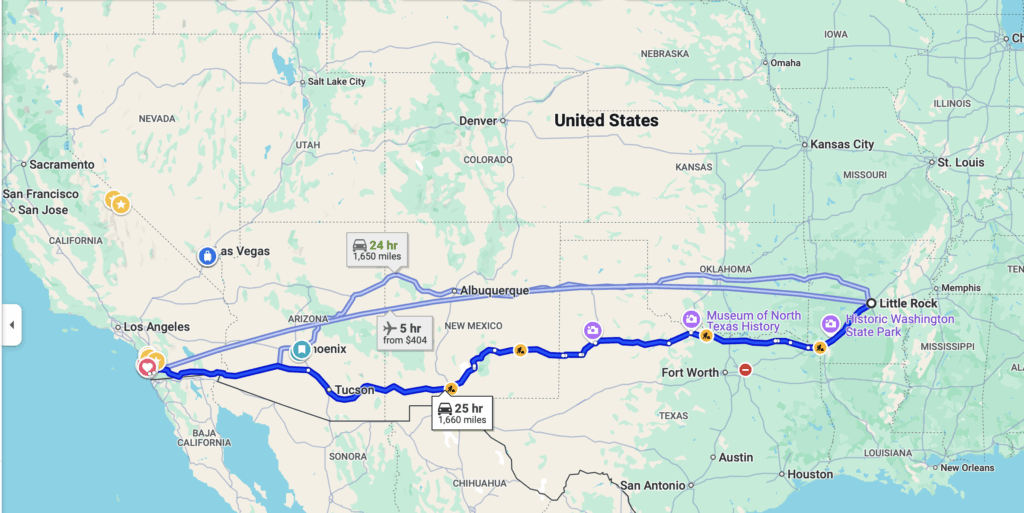
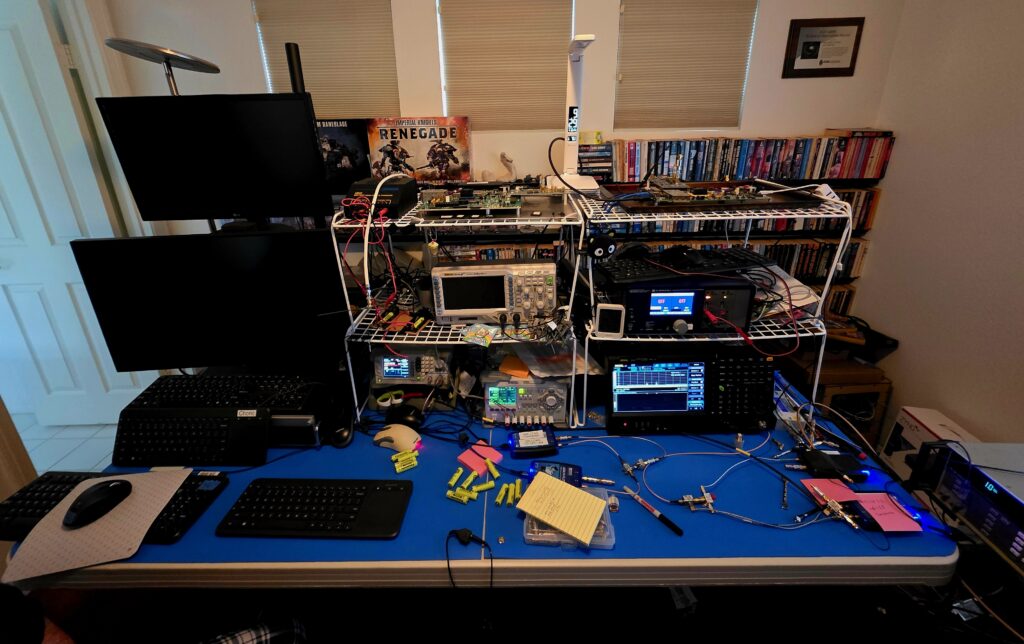
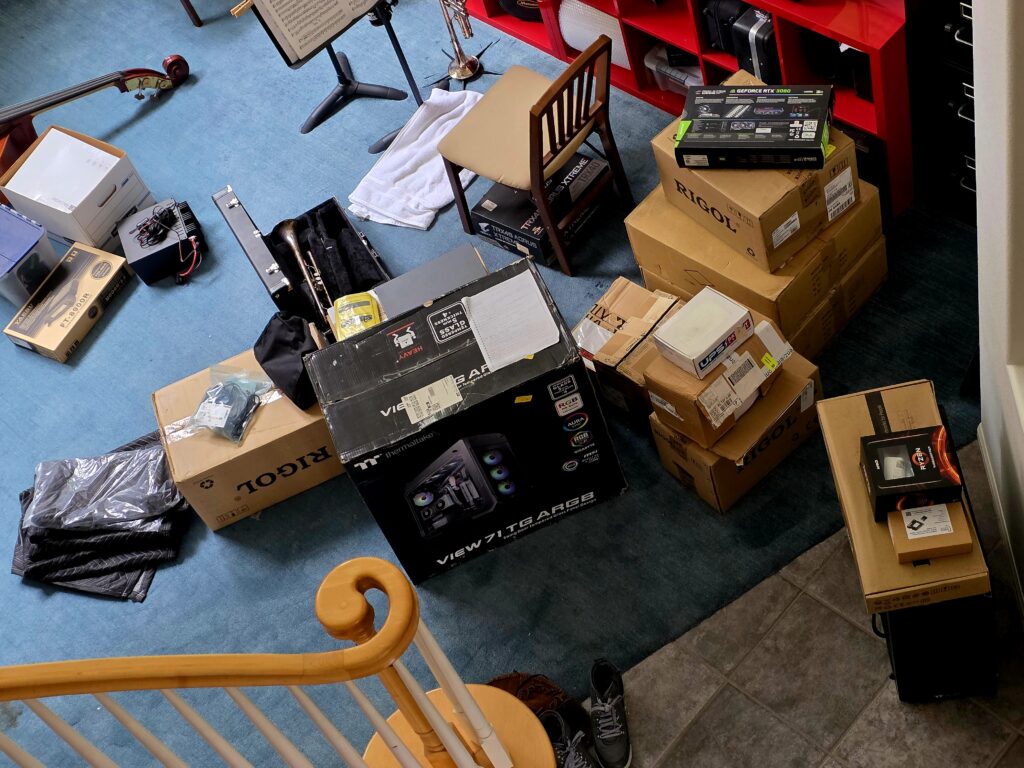
Inner Circle Sphere of Activity
If you know of an event that would welcome ORI, please let your favorite board member know at our hello at openresearch dot institute email address.
31 March 2025 – 219 MHz comments filed with United States Federal Communications Commission https://www.fcc.gov/ecfs/search/search-filings/filing/10329271641887
8 April 2025 – Artificial Intelligence in Amateur Radio presentation by Michelle W5NYV to Northshore Radio Club (vrtual event).
10-17 April 2025 – Remote Lab South equipment relocation.
23-24 April 2025 – ORI attended and volunteered at the Del Mar Electronics and Manufacturing Show in San Diego, CA with an open source digital radio exhibit. We delivered support for the presentation track for event speakers.
Thank you to all who support our work! We certainly couldn’t do it without you.
Anshul Makkar, Director ORI
Frank Brickle, Director ORI (SK)
Keith Wheeler, Secretary ORI
Steve Conklin, CFO ORI
Michelle Thompson, CEO ORI
Matthew Wishek, Director ORI